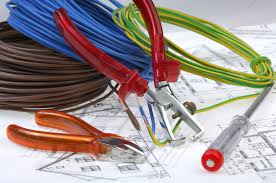 Installation of cables includes fixation of related devices such as sockets, central power boards and switches which allows the electricity distribute according to the requirements of the appliances. Different size and types of cables are used in electrical projects on the basis of its usage such as wires are selected in accordance with the voltage which a circuit is allowing to pass through them and also based on the exposure of environmental conditions where the cable is installed such as moisture and temperature level. This selection of wire is done in accordance with the compliance of safety standards set by the local or international authorities. Safety standards related to wiring may vary from country to country, the international electrotechnical commission (IEC) is responsible to harmonize the standards among the member countries but still, the difference exists in the installation and design of the electric system. These standards are made to keep people safe from shocks and short circuit.
Installation of cables includes fixation of related devices such as sockets, central power boards and switches which allows the electricity distribute according to the requirements of the appliances. Different size and types of cables are used in electrical projects on the basis of its usage such as wires are selected in accordance with the voltage which a circuit is allowing to pass through them and also based on the exposure of environmental conditions where the cable is installed such as moisture and temperature level. This selection of wire is done in accordance with the compliance of safety standards set by the local or international authorities. Safety standards related to wiring may vary from country to country, the international electrotechnical commission (IEC) is responsible to harmonize the standards among the member countries but still, the difference exists in the installation and design of the electric system. These standards are made to keep people safe from shocks and short circuit.
Some basic Information related to cables
Electricians are aware of all the rules and regulations about the cables and installations as well as they are well-informed about the wire codes and colors. If you are planning to do some electrical project in your house, get some information before starting any kind of technical work such as:
Find the perfect level 2 service providers in Sydney you need to repair or remodel the connection. This is generally based on which kind of work, it is going to use for such as if it is required to pass high voltage of current than select the wire which has the capacity to handle the required volts.
Get information about the cable coloring that which color of the cable is of what use which can help in constructing a reliable and consistent The color on each cable informed about the size of the wire inside and amperage power rate. Most of the time the colors indicate the usage of that wire such as a black wire is used for installation of hot connections
Cables have some coded information mentioned on insulation in form of numbers which gives information about the wire like what kind of wire, its size and number of wires in it. Coloring can help to shortlist the required wires and after reading that information can help you get the best match for your project.
Striping a wire needs a special tool to remove the plastic insulation from the metal wire to use it for the connection. It is easy but needs some care and skills to avoid any damage to the wire inside.
Basic electrical projects such as replacing a socket or switches, lengthen the connection and changing the lights can be done by the DIYers but the project which needs more skills, knowledge and also having the high level of risk related to it, should be done by a certified electrician like Level-II service providers.